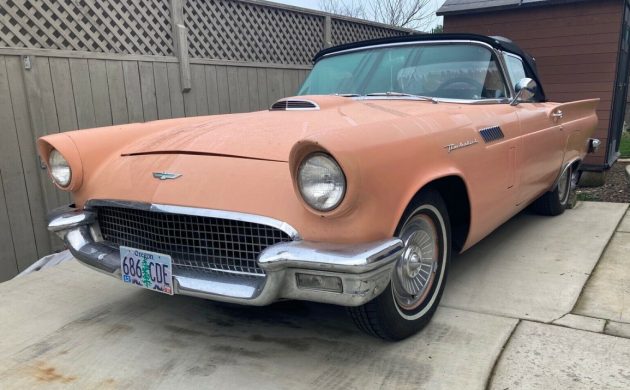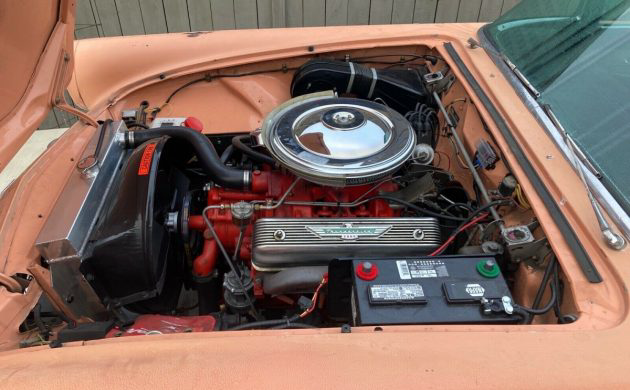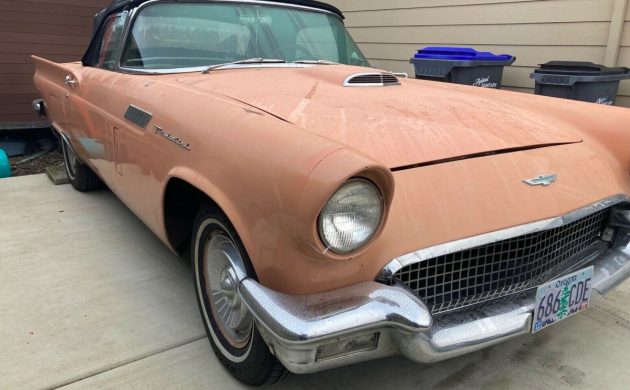Finding a classic car that has been part of the same family for more than six decades is a rare treat, but that’s the story behind this 1957 Ford Thunderbird. Its original lady owner purchased the car from a Californian dealership in early 1958. She used the car as her daily driver until she parked it in 1984. Her son revived the car more than two decades later and has returned it to a roadworthy state. He has been using it as a daily driver himself but has decided that the time is right for it to go to a new family. If you feel that yours could be the right family, you will find the Thunderbird located in Talent, Oregon, and listed for sale here on eBay. Solid bidding has pushed the price to $19,100, but this figure remains short of the reserve.
There’s a bit to consider with this T-Bird. It has spent most of its life in sunny California, only finding its way to Oregon in 2006. Therefore, it’s no surprise to learn that the vehicle is entirely rust-free. Potential buyers can leave the grinder and welder in the cupboard because this classic won’t need them. Its original Coral Sand paint looks tired, but the color is consistent across the entire car. The only previous accident damage that the owner identifies is a minor hit on the front right corner of the car that happened in a parking lot in 1962. His father repaired the damage, but the hood doesn’t align correctly. It may be a case of some minor tweaking and bending that will return this to its factory-correct tolerances. The panels appear perfectly straight, with no dings or dents of any significance. It seems that a simple repaint would have this Thunderbird presenting at its best once again. The soft-top is new, and the seller includes the factory hardtop in the sale. The glass is in good condition for a vehicle of this age, and while some of the chrome might benefit from a trip to the platers, the rest is in good order for a driver-quality car. Alternatively, the buyer may choose to leave things untouched and drive this car proudly as an unmolested survivor.
The owner doesn’t mention any interior restoration work, but the general lack of wear on the seat and carpet suggests that he may have changed both at some point. It looks like there might be a slight seam separation on the driver side of the seat, but the overall impression is pretty positive. If there is a seam separation, a competent upholsterer may be able to address this without the need to spend good money on a new cover. It wears its original combination of Raven Black and Colonial White, and apart from some slight discoloration of the white on the door trims, it presents well. I would be inclined to give the door trims a deep clean because they may respond positively to this. The dash and pad are in excellent condition, with no signs of any damage or deterioration. The factory radio remains intact, and the buyer would be able to drive this car with their head held high.
This Thunderbird rolled off the production line equipped with a 312ci V8 engine and an automatic transmission. When the original owner parked the car back in 1984, it had more than 100,000 miles on the clock, and the seller described it as being pretty tired. When he commenced reviving it in 2006, he sent off its numbers-matching engine and transmission to a specialist for a rebuild. That should allow that sweet V8 to produce somewhere close to its original 245hp. The Thunderbird should cover the ¼ mile in 16.4 seconds with this combination. The engine and transmission have been slotted back into the car, and the seller has recently added an aluminum radiator and auxiliary cooling fan. These later additions mean that the car runs cool on even the hottest days. The news for potential buyers is positive, with this classic running and driving perfectly. The owner uses it as a daily driver and says that he would have no hesitation in slipping behind the wheel at any time for a long journey. That makes it a turnkey proposition for its next lucky owner.
This 1957 Thunderbird is a solid old classic, and the fact that it has already received twenty-one bids suggests that people like what they see. For me, it would be interesting to know whether those potential buyers intend to restore this car to its former glory or drive it as an original survivor. Both options are viable, but the choice will ultimately revolve around a question of personal taste. If you were to buy this classic, which path would you follow?








I would drive it as is while considering what to do with the paint. If a new paint job is decided on does it affect the value of the color is changed?
Sometimes yes, but changing the color here could well increase the value, IMHO.
Seems like these haven’t been enjoying the inflation party and have been stuck around $25K to $50k forever. At least 20 years…
Actually about 40 years. In 1983, I sold a running, red 56 with lots of rust, but a trunk full of NOS parts for $5500. A nice restored one then was around $25,000. Hard to explain.
The e-bay listing shows only one shot of the hardtop – no portholes! It must have been swapped out many years back for some reason or another. Fair example, but even with the SoCal minimum rust pedigree, probably worth a max of $25K IMHO.
That’s the correct 1957 non porthole top.
Nobody wants these cars. Just watch Mecum. Restored beautiful examples struggle to reach 40K. People who like 50s cars are in their 80s. And every passing day they get older.
Not so fast, George. I appreciate and like the 50’s cars and I’m only 68. My first car was a ‘56 Plymouth and my second one a ‘59 Ford.
@David Scully
Porthole tops for the ’57 Thunderbird were an option. Many people think the portholes were standard, but in reality, just another option.
Not exactly. For the ’57 the removable top with portholes was the standard top but you could order the non-porthole top if desired.
Ray Miller’s book Thunderbird was the bible for early Birds when I got my first one in early 1970’s.
According to his reference the non port top was standard in both 1956 and 1957 with the portholes being a no cost option. By 1957 the porthole was the far more popular choice.
Pretty great car there. Not in love with the color but based the car is in phenomenal condition. Its different to see factory seat belts in a 57 that are not frayed and worn, guessing they spent many years under the seat. I would not change a thing just hop in buckle up and ride off into the sunset
I am in my middle 70’s now. That said, I must now admit that I have always wanted one of the little T-birds… yes… since I first saw one when I was a kid. I remember them getting more expensive as I got older… always just above my price range. I did find a 1959 square bird that was in my range and owned it for many years, but it certainly wasn’t a 55, 56, or 57… was it.? Now that they seem to be IN my price range, I just don’t, or can’t, see myself actually buying one. Gosh, I could check out any moment… and leave my wife with trying to get our money out of it.
To ME the coveted colors of the small birds were the odd ones. Like Inca Gold (later Sun Gold, for late production 57), Thunderbird Bronze, Buckskin Tan (56), Willow Green (later Seaspray Green), Thunderbird Green (56), Sunset Coral (56), and Coral Sand (57, which this one is).
The colors looked great on the NEW cars, but as they aged the paint seemed to change to more of a dusky color, almost each of the above did that. The paint would need to be “refreshed” or polished and clear coated. But that might lower the value even more.
Wish I could bring my self to bid on this “little one”.
Just to keep my comments in perspective; I’m 82 years along SoCal type. I had a well-used ’55 ‘Bird (3-speed, o’drive) while in grad school in 1967. Three things bothersome about the ’55 birds; because of seating position, I always got noticeable leg cramps because of left leg positioning needed to work the clutch with the hanging pedals (aided somewhat in ’56 by subtle changes in seat positioning and better cushion support). not much inside ventilation (next year saw the side vents), and a real blind spot on either side with the early top (largely eliminated with the porthole in the next year). I wonder if the porthole deletion option (mentioned by ACD above) gave the buyer any price break on the cost – a test ride with both tops would have sealed any option thoughts by me for sure..
As far as the general public goes the early Tbird is one of the most recognized classic cars on the road. I get more waves and young people wanting to take there picture with the car then any of my others. As for the hard core car guys, they gravitate more to my Tiger and they all seem to have a story about one from when they were in their younger years. The general public and the younger kids don’t have a clue what a Tiger is. Part of the lower thunderbird value is that they made so many of them and most were preserved because it was only a 3 year cycle and they were gone.